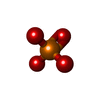[English] 日本語
 Yorodumi
Yorodumi- PDB-5c1d: Human OGT in complex with UDP-5S-GlcNAc and substrate peptide (RB2L) -
+ Open data
Open data
- Basic information
Basic information
| Entry | Database: PDB / ID: 5c1d | ||||||
|---|---|---|---|---|---|---|---|
| Title | Human OGT in complex with UDP-5S-GlcNAc and substrate peptide (RB2L) | ||||||
 Components Components |
| ||||||
 Keywords Keywords | TRANSFERASE / O-GlcNAc transferase Inverting GT-B Substrate complex | ||||||
| Function / homology |  Function and homology information Function and homology informationregulation of lipid kinase activity / negative regulation of non-canonical inflammasome complex assembly / protein N-acetylglucosaminyltransferase complex / regulation of insulin receptor signaling pathway / protein O-acetylglucosaminyltransferase activity / protein O-GlcNAc transferase / positive regulation of transcription from RNA polymerase II promoter by glucose / FOXO-mediated transcription of cell cycle genes / acetylglucosaminyltransferase activity / regulation of Rac protein signal transduction ...regulation of lipid kinase activity / negative regulation of non-canonical inflammasome complex assembly / protein N-acetylglucosaminyltransferase complex / regulation of insulin receptor signaling pathway / protein O-acetylglucosaminyltransferase activity / protein O-GlcNAc transferase / positive regulation of transcription from RNA polymerase II promoter by glucose / FOXO-mediated transcription of cell cycle genes / acetylglucosaminyltransferase activity / regulation of Rac protein signal transduction / regulation of necroptotic process / negative regulation of stem cell population maintenance / protein O-linked glycosylation / Transcription of E2F targets under negative control by p107 (RBL1) and p130 (RBL2) in complex with HDAC1 / NSL complex / Transcription of E2F targets under negative control by DREAM complex / regulation of glycolytic process / RIPK1-mediated regulated necrosis / regulation of gluconeogenesis / negative regulation of G1/S transition of mitotic cell cycle / regulation of synapse assembly / Formation of WDR5-containing histone-modifying complexes / G1/S-Specific Transcription / Sin3-type complex / regulation of neurotransmitter receptor localization to postsynaptic specialization membrane / positive regulation of stem cell population maintenance / phosphatidylinositol-3,4,5-trisphosphate binding / hemopoiesis / positive regulation of proteolysis / histone acetyltransferase complex / G0 and Early G1 / positive regulation of lipid biosynthetic process / Cyclin E associated events during G1/S transition / Cyclin A:Cdk2-associated events at S phase entry / mitophagy / negative regulation of proteasomal ubiquitin-dependent protein catabolic process / negative regulation of protein ubiquitination / response to nutrient / positive regulation of TORC1 signaling / TP53 Regulates Transcription of Genes Involved in G2 Cell Cycle Arrest / negative regulation of cell migration / positive regulation of translation / cell projection / RNA polymerase II transcription regulatory region sequence-specific DNA binding / cellular response to glucose stimulus / promoter-specific chromatin binding / circadian regulation of gene expression / negative regulation of transforming growth factor beta receptor signaling pathway / response to insulin / mitochondrial membrane / protein processing / chromatin DNA binding / Regulation of necroptotic cell death / Cyclin D associated events in G1 / UCH proteinases / positive regulation of cold-induced thermogenesis / chromosome / HATs acetylate histones / chromatin organization / transcription regulator complex / cell differentiation / negative regulation of gene expression / apoptotic process / regulation of transcription by RNA polymerase II / chromatin / positive regulation of DNA-templated transcription / nucleolus / glutamatergic synapse / negative regulation of transcription by RNA polymerase II / signal transduction / positive regulation of transcription by RNA polymerase II / protein-containing complex / extracellular exosome / nucleoplasm / nucleus / plasma membrane / cytosol Similarity search - Function | ||||||
| Biological species |  Homo sapiens (human) Homo sapiens (human) | ||||||
| Method |  X-RAY DIFFRACTION / X-RAY DIFFRACTION /  SYNCHROTRON / SYNCHROTRON /  MOLECULAR REPLACEMENT / Resolution: 2.05 Å MOLECULAR REPLACEMENT / Resolution: 2.05 Å | ||||||
 Authors Authors | Schimpl, M. / Rafie, K. / van Aalten, D.M.F. | ||||||
 Citation Citation |  Journal: Nat.Struct.Mol.Biol. / Year: 2015 Journal: Nat.Struct.Mol.Biol. / Year: 2015Title: The active site of O-GlcNAc transferase imposes constraints on substrate sequence. Authors: Pathak, S. / Alonso, J. / Schimpl, M. / Rafie, K. / Blair, D.E. / Borodkin, V.S. / Schuttelkopf, A.W. / Albarbarawi, O. / van Aalten, D.M. | ||||||
| History |
|
- Structure visualization
Structure visualization
| Structure viewer | Molecule:  Molmil Molmil Jmol/JSmol Jmol/JSmol |
|---|
- Downloads & links
Downloads & links
- Download
Download
| PDBx/mmCIF format |  5c1d.cif.gz 5c1d.cif.gz | 163.6 KB | Display |  PDBx/mmCIF format PDBx/mmCIF format |
|---|---|---|---|---|
| PDB format |  pdb5c1d.ent.gz pdb5c1d.ent.gz | 124 KB | Display |  PDB format PDB format |
| PDBx/mmJSON format |  5c1d.json.gz 5c1d.json.gz | Tree view |  PDBx/mmJSON format PDBx/mmJSON format | |
| Others |  Other downloads Other downloads |
-Validation report
| Summary document |  5c1d_validation.pdf.gz 5c1d_validation.pdf.gz | 777.4 KB | Display |  wwPDB validaton report wwPDB validaton report |
|---|---|---|---|---|
| Full document |  5c1d_full_validation.pdf.gz 5c1d_full_validation.pdf.gz | 781.1 KB | Display | |
| Data in XML |  5c1d_validation.xml.gz 5c1d_validation.xml.gz | 28.8 KB | Display | |
| Data in CIF |  5c1d_validation.cif.gz 5c1d_validation.cif.gz | 41.8 KB | Display | |
| Arichive directory |  https://data.pdbj.org/pub/pdb/validation_reports/c1/5c1d https://data.pdbj.org/pub/pdb/validation_reports/c1/5c1d ftp://data.pdbj.org/pub/pdb/validation_reports/c1/5c1d ftp://data.pdbj.org/pub/pdb/validation_reports/c1/5c1d | HTTPS FTP |
-Related structure data
| Related structure data |  4xi9C 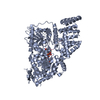 4xifC  5bnwC  3pe4S S: Starting model for refinement C: citing same article ( |
|---|---|
| Similar structure data |
- Links
Links
- Assembly
Assembly
| Deposited unit | 
| |||||||||
|---|---|---|---|---|---|---|---|---|---|---|
| 1 |
| |||||||||
| Unit cell |
| |||||||||
| Components on special symmetry positions |
|
- Components
Components
| #1: Protein | Mass: 80974.508 Da / Num. of mol.: 1 / Fragment: UNP residues 313-1031 Source method: isolated from a genetically manipulated source Source: (gene. exp.)  Homo sapiens (human) / Gene: OGT / Production host: Homo sapiens (human) / Gene: OGT / Production host:  | ||
|---|---|---|---|
| #2: Protein/peptide | Mass: 744.833 Da / Num. of mol.: 1 / Fragment: UNP residues 416-423 / Source method: obtained synthetically Details: Nitrogen from residue 8 results from an acetylation during chemical synthesis of the compound and is part of residue 7 but needed a different residue number in the PDB Source: (synth.)  Homo sapiens (human) / References: UniProt: Q08999 Homo sapiens (human) / References: UniProt: Q08999 | ||
| #3: Chemical | ChemComp-12V / ( | ||
| #4: Chemical | | #5: Water | ChemComp-HOH / | |
-Experimental details
-Experiment
| Experiment | Method:  X-RAY DIFFRACTION X-RAY DIFFRACTION |
|---|
- Sample preparation
Sample preparation
| Crystal | Density Matthews: 3.22 Å3/Da / Density % sol: 61.84 % |
|---|---|
| Crystal grow | Temperature: 294.15 K / Method: vapor diffusion, hanging drop / pH: 6.4 Details: 1.45 M Potassium diohydrogen phosphate, 8 mM EDTA, 1% xylitol (reservoir). 1.45 M Potassium diohydrogen phosphate, 8 mM EDTA, 1% xylitol, 0.5 M Ammonium sulfate (drop) |
-Data collection
| Diffraction | Mean temperature: 100 K |
|---|---|
| Diffraction source | Source:  SYNCHROTRON / Site: SYNCHROTRON / Site:  ESRF ESRF  / Beamline: MASSIF-3 / Wavelength: 0.9677 Å / Beamline: MASSIF-3 / Wavelength: 0.9677 Å |
| Detector | Type: PSI PILATUS 6M / Detector: PIXEL / Date: May 1, 2015 |
| Radiation | Protocol: SINGLE WAVELENGTH / Monochromatic (M) / Laue (L): M / Scattering type: x-ray |
| Radiation wavelength | Wavelength: 0.9677 Å / Relative weight: 1 |
| Reflection | Resolution: 2.05→46.2 Å / Num. all: 443970 / Num. obs: 65809 / % possible obs: 100 % / Redundancy: 6.7 % / Rmerge(I) obs: 0.07 / Net I/σ(I): 17.4 |
| Reflection shell | Resolution: 2.05→2.16 Å / Redundancy: 6.6 % / Rmerge(I) obs: 0.826 / Mean I/σ(I) obs: 2.5 / % possible all: 100 |
- Processing
Processing
| Software |
| ||||||||||||||||||||||||||||||||||||||||||||||||||||||||||||||||||||||||||||||||||||||||||||||||||||||||||||||||||||||||||||||||||||||||||||||||||||||||||||||||||||||||||||||||||||||
|---|---|---|---|---|---|---|---|---|---|---|---|---|---|---|---|---|---|---|---|---|---|---|---|---|---|---|---|---|---|---|---|---|---|---|---|---|---|---|---|---|---|---|---|---|---|---|---|---|---|---|---|---|---|---|---|---|---|---|---|---|---|---|---|---|---|---|---|---|---|---|---|---|---|---|---|---|---|---|---|---|---|---|---|---|---|---|---|---|---|---|---|---|---|---|---|---|---|---|---|---|---|---|---|---|---|---|---|---|---|---|---|---|---|---|---|---|---|---|---|---|---|---|---|---|---|---|---|---|---|---|---|---|---|---|---|---|---|---|---|---|---|---|---|---|---|---|---|---|---|---|---|---|---|---|---|---|---|---|---|---|---|---|---|---|---|---|---|---|---|---|---|---|---|---|---|---|---|---|---|---|---|---|---|
| Refinement | Method to determine structure:  MOLECULAR REPLACEMENT MOLECULAR REPLACEMENTStarting model: 3PE4 Resolution: 2.05→46.2 Å / Cor.coef. Fo:Fc: 0.962 / Cor.coef. Fo:Fc free: 0.949 / SU B: 5.245 / SU ML: 0.131 / Cross valid method: THROUGHOUT / ESU R: 0.157 / ESU R Free: 0.146 / Stereochemistry target values: MAXIMUM LIKELIHOOD / Details: HYDROGENS HAVE BEEN ADDED IN THE RIDING POSITIONS
| ||||||||||||||||||||||||||||||||||||||||||||||||||||||||||||||||||||||||||||||||||||||||||||||||||||||||||||||||||||||||||||||||||||||||||||||||||||||||||||||||||||||||||||||||||||||
| Solvent computation | Ion probe radii: 0.8 Å / Shrinkage radii: 0.8 Å / VDW probe radii: 1.2 Å / Solvent model: MASK | ||||||||||||||||||||||||||||||||||||||||||||||||||||||||||||||||||||||||||||||||||||||||||||||||||||||||||||||||||||||||||||||||||||||||||||||||||||||||||||||||||||||||||||||||||||||
| Displacement parameters | Biso mean: 45.3 Å2
| ||||||||||||||||||||||||||||||||||||||||||||||||||||||||||||||||||||||||||||||||||||||||||||||||||||||||||||||||||||||||||||||||||||||||||||||||||||||||||||||||||||||||||||||||||||||
| Refinement step | Cycle: LAST / Resolution: 2.05→46.2 Å
| ||||||||||||||||||||||||||||||||||||||||||||||||||||||||||||||||||||||||||||||||||||||||||||||||||||||||||||||||||||||||||||||||||||||||||||||||||||||||||||||||||||||||||||||||||||||
| Refine LS restraints |
|
 Movie
Movie Controller
Controller



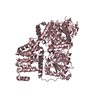
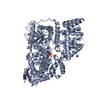


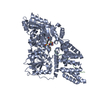




 PDBj
PDBj


















